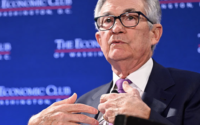Fed Officials Lean Into Higher Rates as Inflation Keeps Going
(Bloomberg) — Federal Reserve officials said interest rates will need to increase further and stay elevated into next year to curb US inflation that’s showing few signs of abating despite the central bank’s most aggressive monetary tightening in a generation.
Most Read from Bloomberg
Interest rates would need to rise to between 5% and 5.25% and then remain there “until well into 2024,” Atlanta Fed President Raphael Bostic wrote in an essay published Wednesday. “This will allow tighter policy to filter through the economy and ultimately bring aggregate supply and aggregate demand into better balance and thus lower inflation.”
Bank of Minneapolis President Neel Kashkari has yet to decide if he will back accelerating the central bank’s interest-rate increases when officials meet later this month, amid signs inflation is not cooling as hoped.
“I’m open-minded, at this point, about whether it’s 25 or 50 basis points,” Kashkari said Wednesday in a question-and-answer session in Sioux Falls, South Dakota. “To me, much more important than whether it’s 25 or 50 is what we signal in what’s called the dot plot,” he added, referring to the Fed’s quarterly forecast for the path of its benchmark policy rate.
The central bank raised that rate by a quarter percentage point to a range of 4.5% to 4.75% on Feb. 1. The smaller move followed a half-point increase in December and four jumbo-sized 75 basis-point hikes prior to that.
“We’re not yet seeing much of a sign of our interest-rate increases slowing down the services sector of the economy and that is concerning to me,” Kashkari said. “Wage growth is at a level that it actually is too high to be consistent” with the 2% inflation target.
‘Disastrous Results’
Fed officials are focused on bringing down inflation in core services excluding housing, a part of the economy that has remained strong despite tightening monetary policy — a “concerning” issue, Kashkari said. Prices in that category, where wages account for a large part of costs, rose at a 4.6% annual pace in January, up from 4.3% in December, according to the Fed’s preferred inflation gauge.
Minutes from the January discount-rate meetings showed that directors from the Minneapolis Fed favored a 50 basis-point hike in that rate. Those votes are typically a proxy for how the president would like to vote on the federal funds rate at the upcoming Federal Open Market Committee meeting.
Minutes from the Jan. 31-Feb. 1 FOMC meeting showed that “a few” participants favored or could have supported a 50 basis-point increase. But Kashkari, who votes on policy this year, ultimately joined his colleagues in voting for the smaller raise.
Kashkari reiterated that in December he saw the fed funds rate rising to as high as 5.4% in this tightening cycle. He said Wednesday he hasn’t yet decided where his new estimate will be at the March meeting, when policymakers provide their quarterly forecast updates, but that he’s leaning toward supporting more rate increases. Financial-market bets for the peak rate reached 5.5% Wednesday.
Several recent reports have shown inflation accelerated more than forecast in January, a surprising pivot after prices had cooled in the last three months of 2022. The labor market also remained tight at the beginning of the year, with employers adding a whopping 517,000 jobs in January.
“History teaches that if we ease up on inflation before it is thoroughly subdued, it can flare anew,” Bostic said in an essay on the Atlanta Fed’s website. “That happened with disastrous results in the 1970s.”
Bringing down inflation remains the Fed’s No. 1 job, Kashkari said. While the US economy is not yet in a recession, history shows that tighter monetary policy usually leads to one.
“Typically, when the central bank has caused a recession by raising interest rates, the bounce back can be very fast,” he said.
Most Read from Bloomberg Businessweek
©2023 Bloomberg L.P.
[ad_2]
Source link


